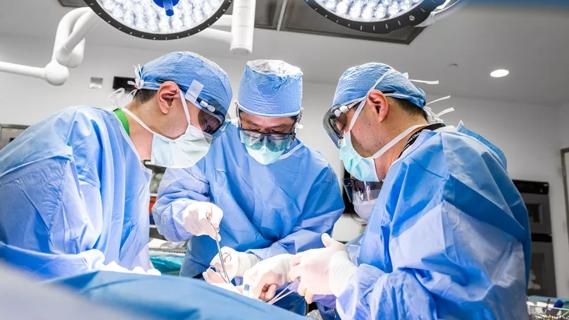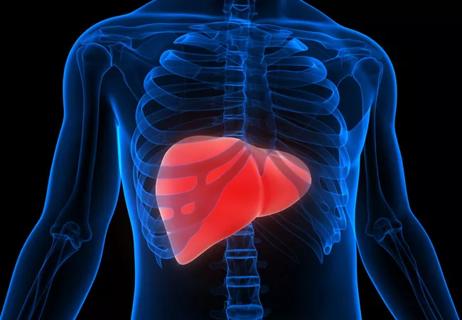Confirming their clinical suspicions, Cleveland Clinic researchers and their collaborators have found that patients with inflammatory bowel disease (IBD) experience higher rates of nonalcoholic fatty liver disease, nonalcoholic steatohepatitis and nonalcoholic cirrhosis compared to the general U.S. population in two nationally representative epidemiological studies.
Cleveland Clinic is a non-profit academic medical center. Advertising on our site helps support our mission. We do not endorse non-Cleveland Clinic products or services. Policy
Miguel Regueiro, MD, Chair of the Department of Gastroenterology, Hepatology & Nutrition and colleagues from Cleveland Clinic and University Hospitals discovered significantly greater prevalence of these challenging liver conditions by analyzing a database of nearly 160,000 patients with Crohn’s disease and more than 125,000 patients with ulcerative colitis.
The results indicate that the presence of IBD conveys increased risk of comorbid liver disease, although the precise relationship and etiology remain unknown.
Findings from the two studies were presented at Digestive Disease Week 2019.
Some concerning trends prompted the research. “Fatty liver disease is increasing in prevalence in the United States and we were interested in determining if IBD is a separate risk factor for nonalcoholic fatty liver disease [NAFLD],” Dr. Regueiro says.
“We know that IBD has been associated with primary sclerosing cholangitis, and that many of the medications we prescribe affect the liver.” However, he adds, “the contribution of IBD to NAFLD is not known – and we hypothesize may be an underrecognized extra-intestinal manifestation of IBD.”
To find out more, Dr. Regueiro, lead author Muhammad Talal Sarmini, MD, and their colleagues studied diagnosis codes in Explorys Inc. electronic medical records. This commercial database covers 26 major integrated healthcare systems nationwide.
From more than 62 million patients, they identified 159,290 people diagnosed with Crohn’s disease (CD) and 125,380 diagnosed with ulcerative colitis (UC) between 1999 and 2018. Next, the researchers looked for people with newly diagnosed NAFLD, nonalcoholic steatohepatitis (NASH) or nonalcoholic cirrhosis (NC) more than 30 days following their CD diagnosis.
In the CD population, the NAFLD prevalence was 2.4%, 0.3% for NASH and 0.9% for NC. Among the UC cohort, NAFLD prevalence was 1.95% 0.23% for NASH and 1.01% for NC. All of those rates were significantly higher than the liver disease rates among the total population in the Explorys database.
“We were surprised to see such a high rate of fatty liver disease in our IBD patients,” Dr. Regueiro says. “The rates of abnormal liver function tests and NAFLD were much higher than we anticipated in the Crohn’s disease and ulcerative colitis patient cohorts.”
In terms of risk factors, compared to people with CD and no NAFLD, comorbid patients were 17% more likely to be female, 87% more likely to be Caucasian and 19% more likely to be older than 65. Compared to individuals with CD and no NASH, those with both conditions were 42% more likely to be female, 119% more likely to be Caucasian and 58% more likely to be elderly. Those with both CD and NC were 21% more likely to be males, 39% more likely to be Caucasian and 245% more likely to be older than 65.
Compared to patients with UC and no NAFLD, comorbid patients were 85% more likely to be Caucasian. Unlike the CD cohort, however, risk for NAFLD was not elevated based on sex or age.
The comorbid UC/NASH group was 211% more likely to be Caucasian and 42% more likely to be older than 65. The researchers found no increased risk based on gender.
The group with both UC and NC were 58% more likely to be men and 29% more likely to be elderly.
The researchers also found that individuals with CD or UC and comorbid NAFLD or NASH were significantly more likely than their counterparts without liver disease to have diabetes mellitus, obesity and hypertension. This finding raises the possibility of metabolic risk factors linking IBD and advanced liver diseases.
“Our hypothesis is that there is an immune-mediated reason for increased fatty liver and liver disease in general in IBD,” says Dr. Regueiro. A pro-inflammatory cytokine process, an alteration to the microbiome and/or genetic factors are possibilities. “Also, there are probably metabolic changes in IBD that promote fat deposition in the liver that had previously been thought to only occur in such diseases as diabetes and obesity.”
Regarding the findings’ clinical applications, “we need to recognize that fatty liver disease is common in IBD,” Dr. Regueiro says. “This is particularly important as we monitor patients for liver disease and prescribe medications that are metabolized by and may affect the liver.
“We should screen regularly for liver disease in our IBD patients, at least with liver function blood tests,” he says. “In the future we may use imaging modalities or other biomarkers to assess for liver disease in our IBD patients.”
Going forward, Dr. Regueiro and team are launching a large, prospective study to evaluate the phenotype of IBD patients at Cleveland Clinic.
“One goal is “to understand the ‘-omics’ of their disease,” he says. “We’re interested in looking for disease patterns through big data and natural language processing, and applying translational research in proteomics, metabolomics, genomics, microbiomics, and immunologic processes to our patients.”
“We’re hoping that these discoveries will lead to precision medicine for our patients and better treatment.”
Histological image of nonalcoholic cirrhosis courtesy of Lisa M. Yerian, MD.

Careful risk stratification is key

Findings support the safety of the technique

Insights from murine models could help guide care for patients

Reviewing how the drug can be incorporated into care

Largest, longest analysis to date shows greater weight loss and fewer diabetes medications needed

The importance of raising awareness and taking steps to mitigate these occurrences

New research indicates feasibility and helps identify which patients could benefit

Standardized and collaborative care improves liver transplantations